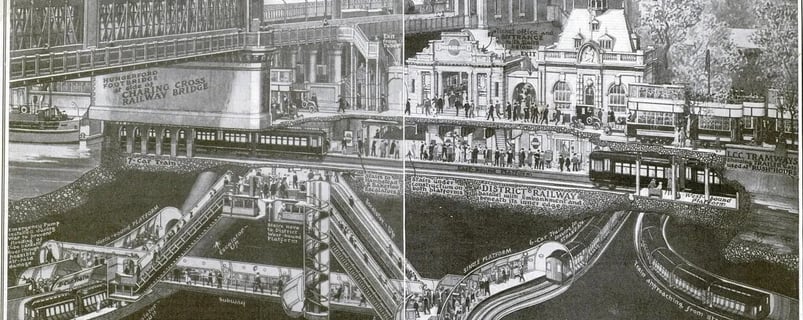Urban ground
'City Ground'. Online article by Stephen Graham 2016
In his book, Vertical, Graham had described the all-too-often neglected vertical dimension of cities. Here he continues that theme but zooms in to examine the depth of humanly modified strata - the urban archaeosphere - as an important element of that vertical dimension. From the huge mound of war rubble known as the Teufelsberg or Devil's Mountain in Berlin to equally impressive mound of broken amphorae known as Monte Testaccio in Rome, from Chicago to Mexico City and Singapore to San Francisco, this is a very readable overview of urban ground from a geographic perspective
Graham, S. 2016. City Ground. Places Journal. November. Online here
“Mark Williams: ‘Cities will leave a clear and globally widespread geological record of their impact that will persist for millions of years’”. Online article based on an interview by Lucas Tiphine (2020)
A compelling account of the stratigraphic traces that will be left behind in the geological record. Much of the near-surface urban strata, it is pointed out, will be eroded away. What will leave the most durable and lasting record in the ground will be deep structures such as metros, surviving for millions of years by virtue of being deeply buried and therefore protected from erosive forces operating on the surface.
Agreed, although a weakness of the argument lies in an attempt to combine it with the case for a mid-20th century start date for the Anthropocene. Like most elements of the archaeosphere, the global stratigraphic signal of underground metros is highly diachronous, and manifestly so. It is spread out over 160 years, and still very much in the process of formation. If ever a set of evidence was indicative of an unfolding and intensifying Anthropocene event, rather than an epoch with a fixed start, this is surely it.
Tiphine, L. 2020. “Mark Williams: Cities will leave a clear and globally widespread geological record of their impact that will persist for millions of years’”. Anthropocene 2050. November 26, 2020. Online here


Cutaway of London’s underground metro at Charing Cross Station (now Embankment Station), taken from the Popular Science Magazine, January 1921, pp. 44–45, drawing by S.W. Clatworthy.
City-Strata of the Anthropocene. Paper by Zalasiewicz, Jan., Waters, Colin., Williams, Mark. (2017)
Following on from the above, I found the same argument here, except in this paper it is not just metros but the whole of urban ground that is meant to have transitioned from a Holocene state to the Anthropocene state in about the year 1950. According to the authors, “Anthropocene city-strata [i.e. post-1950] can be readily distinguished from their Holocene [i.e. pre-1950] predecessors”.
As an archaeologist who has hand-dug his way through deep urban stratigraphy in cities as far apart as London and Carthage, I can say categorically that this is not the case. Things change and intensify over time, for sure, there are shifts in types and abundance of materials found, but these are highly diachronous signals. There is no stratigraphic signal of a sudden shift from one epoch to another that happens to fall in precisely in 1950.
Otherwise this is a great paper about city strata. Following Suess, the authors rightly treat urban strata as geological material. There is discussion here on the novel question of how much a city weighs and its effects on the Earth’s crust, considering the weight of the platform of archaeosphere material on which the city stands as well as that of buildings and infrastructure. Fascinating. Shame though that the occasionally brilliant thinking of the AWG, and their understanding of highly diachronous material evidence in the ground, has to be distorted at every turn to fit the already decided-upon fixed start date of a conceptual time interval!
Zalasiewicz J, Waters C, Williams M. 2017. Annales Histoire, Sciences Sociales 72(2):225-245. doi:10.1017/ahsse.2019.11 (not open access)
Quantifying anthropogenic modification of the shallow geosphere in central London, UK. Paper by Terrington et al. (2018).
In the middle of an otherwise sound paper, an extraordinary claim is made. It is stated that 37% of the anthropogenic ground in the City of London is post-1945 in date, and corresponds therefore to the proposed Anthropocene epoch starting in the mid-20th century. To an archaeologist like me who has excavated on numerous sites in the city, from the modern concrete and tarmac surfaces at the top, through successions of post-medieval, medieval and Roman strata, this seemed an unfeasibly high proportion. I spent some time in trying to understand how they could possibly have reached such an over-estimation of post-1945 deposits and corresponding under-estimation of pre-1945 deposits (more on this to be added later).
Terrington, R.L., Silva, É.C.N., Waters, C.N. Smith, H., and Thorpe. S. 2018. Quantifying anthropogenic modification of the shallow geosphere in central London, UK. Geomorphology 319, 15-34, https://doi.org/10.1016/j.geomorph.2018.07.005 (not open access)